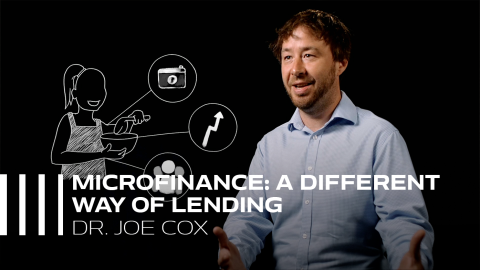

Diverse international benefits have occurred due to research led by Andy Thorpe on Microfinance.
The growth of a lender base and changes to various international loan selection and supervision processes have led to increased lending, facilitating improvements to the lives of poor people through financial inclusion.
The Challenge
‘Pro-social’ donors - those who provide interest-free loans to borrowers - using the platform Lendwithcare (LWC) exhibit significant variations in the value and quantity of loans provided.
What did we do?
Andy Thorpe and his team investigated patterns in lender profiles and their lending behaviours in order to determine the factors which influence individuals engagement with the lending scheme. Through this research they determined how best to attract new lenders and represent the profiles of borrowers in order to optimise lending behaviours.
The research team also provided training, workshops and support to participants internationally, informing the practices of microfinance platforms across the world.
The Impact
LWC redesigned their platform based on the recommendations of the research team. The changes helped LWC to more effectively target their fund-raising campaigns to potential donor groupings, and tailor them to give greater authority to the campaigns, resulting in an increase of lenders by 217% and an increase of over £25 million lent across the course of the study.
Training for representatives from other platforms shaped policy recommendations and management decisions, improving their microcredit programmes. Changes facilitated access to microfinance for poorer segments of female entrepreneurs and marginalised groups in particular.
Microfinance: a different way of lending

What fascinates me about microfinance is the fact that
0:05
it's a sustainable way of helping
0:08
low income, marginalised and vulnerable communities,
0:12
and we think the ultimate thing that we’re trying to do through
0:15
microfinance and the Lendwithcare project,
0:17
is to make people more financially independent, more self-reliant.
0:23
In the longer term, I think that's the only real solution
0:27
to poverty.
0:30
Lendwithcare is a microfinance crowdfunding platform.
0:35
So, what it does essentially is that it attracts support
0:38
from thousands of people in the UK, mostly,
0:42
although we have lots of people based in other countries as well.
0:45
They see the profile of somebody with a small business
0:48
somewhere around the world with an idea that they want to develop
0:52
and they say, I want to support that.
0:54
So they go onto the website, they make a loan.
0:58
Once the loan is fully funded, we collect the money
1:02
and we transfer it to a local partner organisation overseas.
1:06
They're the ones who will have
1:08
appraised the loan application of the person.
1:10
Hopefully it's successful and they repay the money
1:13
and it goes back eventually to your account as well as a lender in the UK.
1:21
Myself and my colleagues, we
1:23
came into contact with Lendwithcare
1:24
when they were relatively newly established
1:27
and we worked with them over a period of several years to help them
1:31
look at how they were presenting entrepreneur profiles,
1:35
how they were setting up their website
1:37
to encourage people to contribute.
1:39
The research I specifically lead, I was really interested in looking
1:42
at how contributors on the Lendwithcare platform behave.
1:46
When you sign up to the Lendwithcare website,
1:48
you create a profile, if you wish,
1:50
and you can tell people about who you are and why you lend.
1:54
A lot of the ones I was reading were quite
1:57
keen to kind of emphasize what good people they were.
2:00
You know, they'd have photos of themselves
2:03
climbing Everest and then you had other people
2:06
who just were kind of anonymous and I think very deliberately so.
2:10
And I was really interested in looking at
2:12
whether there was any difference in the behaviors between these people.
2:15
Economic theory
2:16
kind of suggests that one reason why people might give to charity
2:19
is to enhance their reputation or their image.
2:22
So I was working on the assumption that people who create these
2:25
kind of outlandish profiles of themselves
2:28
possibly had more of an image concern
2:31
than those who decided to contribute anonymously.
2:34
So given that the number of campaigns is visible,
2:37
but the amount of money given is not visible,
2:40
I hypothesised that people who are more image concerned
2:44
would want to give a greater number of loans,
2:48
but would give smaller amounts to each one to kind of maximise the
2:52
image they were presenting.
2:54
And that's exactly what we found.
2:56
So that helped inform Lendwithcare about the type of lenders
2:59
they're working with
3:00
and the incentives
3:01
and the motivations that are driving their behaviours.
3:04
We've made recommendations to them
3:05
about how they could better engage and incentivise that kind of thing.
3:09
It's just good to be able
3:10
to understand that
3:11
and to get a better insight into how you can encourage
3:14
these types of contributors to give more money.
3:18
Well, I think from the perspective of Lendwithcare,
3:20
the process was that they were doing a lot of work
3:23
internationally in developing countries
3:25
but weren't really getting a sense of
3:27
whether what they were doing was making any real difference to people.
3:30
I think they were getting a lot of questions
3:32
from their contributors about, you know, how their money was being used
3:36
and how it was affecting the lives of entrepreneurs.
3:39
So Lendwithcare were quite keen to get independent
3:42
academic assessment of just how much impact these loans
3:45
were actually having to entrepreneurs, both to help sort of present
3:48
evidence to the public and to CARE International.
3:52
But I think also so they could get a sense of the power behind
3:55
what they were doing and how it was,
3:57
you know, really making a difference and changing people's lives.
4:16
We've recently begun a partnership this year
4:18
with an organization called Doselva, which is based in Nicaragua.
4:22
So what essentially Doselva does is it helps smallholder farmers
4:27
to cultivate high value organic spices.
4:32
A hectare of maize, for example,
4:35
which is kind of the most traditional crops in Central America,
4:39
you might get about $290 per hectare.
4:42
You start producing things like turmeric and it's $1900 per hectare,
4:48
and then you start producing ginger, which is $2800 per hectare.
4:53
So suddenly your level of profit per farmer
4:56
has increased by sixfold,
4:58
once you've taken out the costs of production.
5:00
These crops,
5:01
they can be grown in conjunction with the existing forest canopy.
5:07
So you don't need to chop down trees.
5:09
In areas that are particularly sensitive to deforestation
5:13
or on the buffer zones of protected biosphere
5:16
parks, these are the crops that are ideally suited.
5:20
I recently spoke with the CEO of Doselva, our partner
5:23
in Nicaragua, and I said, “This is such a wonderful idea.
5:27
It makes so much economic sense, it makes so much environmental sense.
5:32
Why couldn't you get it going?”
5:34
And he said, “Look, it's such an innovative project
5:37
that nobody would take the risk in financing us.
5:40
With Lendwithcares funding, this project
5:42
simply wouldn't have been possible but you've been prepared to take
5:45
the risk and fund us.”
5:48
And I think one of the reasons that we took that risk is
5:52
because we have the flexibility.
5:54
Our lenders, the thousands of people that support Lendwithcare,
5:57
actively want us to do this sort of work
6:00
because it's the sort of project that makes the most sense.
6:06
The next phase of Lendwithcare is that we want to roll out the research
6:10
to other countries.
6:12
Every country where we work is different and what we want to do really:
6:17
to better help the people that we want to help,
6:20
we better need to understand the challenges that they face.
6:23
Lendwithcare and the University of Portsmouth
6:26
have been in a long term partnership for about seven years now,
6:30
and it's been a relationship that I think we've benefited
6:33
tremendously from.
6:35
The collaboration has enabled us to produce high level,
6:39
scientific, independent evidence
6:42
and address the fundamental question,
6:45
“What impact is Lendwithcare having on the people that we support?”
6:50
We've been involved in this period of quite rapid expansion
6:53
with Lendwithcare,
6:53
and I'd like to think a lot of the recommendations and insights
6:56
we've offered them in terms of
6:59
how to reach out to the public, how to engage them more effectively.
7:04
We've made a significant impact on how they've been able
7:07
to grow and develop over that time.
7:09
Neither we at Lendwithcare or our partners
7:13
have the expertise of the University of Portsmouth,
7:15
so that's where the assistance is so vital.
